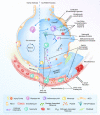Translational medicine for acute lung injury
- PMID: 38183140
- PMCID: PMC10768317
- DOI: 10.1186/s12967-023-04828-7
Translational medicine for acute lung injury
Abstract
Acute lung injury (ALI) is a complex disease with numerous causes. This review begins with a discussion of disease development from direct or indirect pulmonary insults, as well as varied pathogenesis. The heterogeneous nature of ALI is then elaborated upon, including its epidemiology, clinical manifestations, potential biomarkers, and genetic contributions. Although no medication is currently approved for this devastating illness, supportive care and pharmacological intervention for ALI treatment are summarized, followed by an assessment of the pathophysiological gap between human ALI and animal models. Lastly, current research progress on advanced nanomedicines for ALI therapeutics in preclinical and clinical settings is reviewed, demonstrating new opportunities towards developing an effective treatment for ALI.
Keywords: Acute lung injury; Acute respiratory distress syndrome; Animal model; Drug delivery; Nanomedicine; Therapy.
© 2024. The Author(s).
Conflict of interest statement
The authors declare no competing interests.
Figures



References
Publication types
MeSH terms
LinkOut - more resources
Full Text Sources
Miscellaneous

